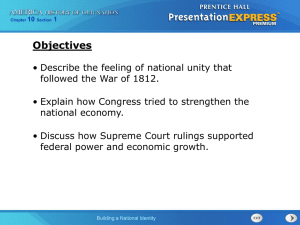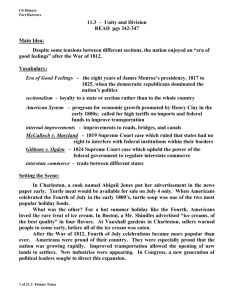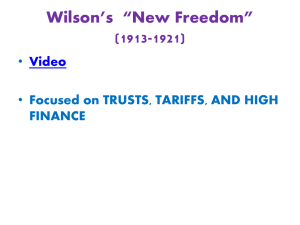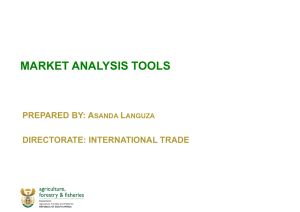Chapter 10 Section 1
advertisement
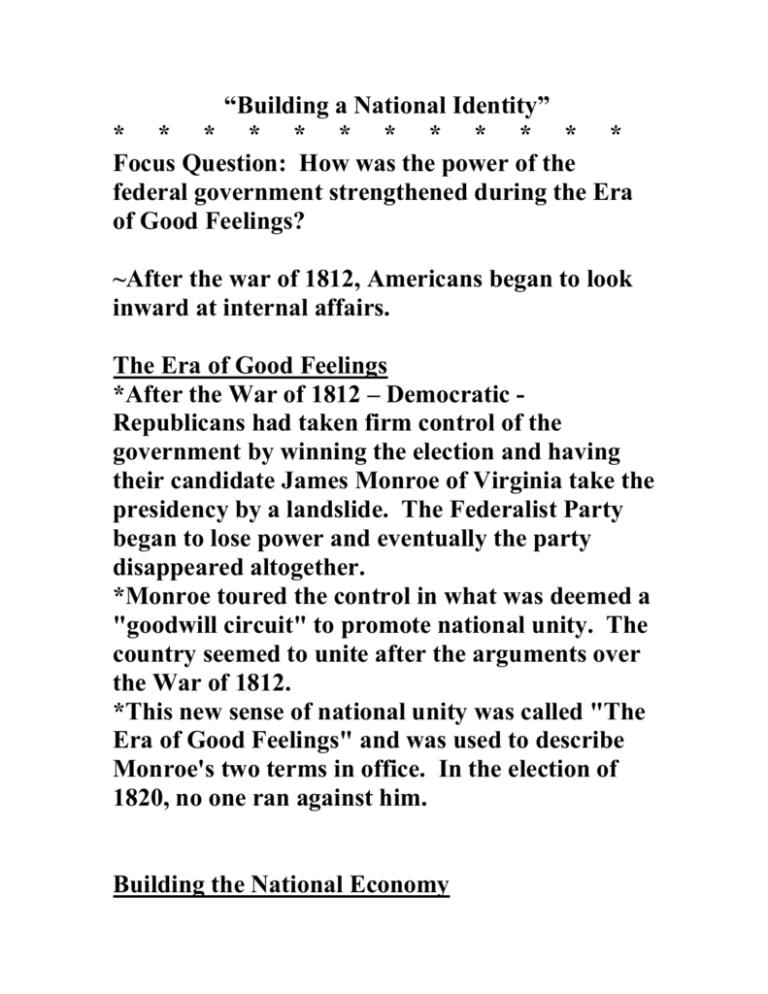
“Building a National Identity” * * * * * * * * * * * * Focus Question: How was the power of the federal government strengthened during the Era of Good Feelings? ~After the war of 1812, Americans began to look inward at internal affairs. The Era of Good Feelings *After the War of 1812 – Democratic Republicans had taken firm control of the government by winning the election and having their candidate James Monroe of Virginia take the presidency by a landslide. The Federalist Party began to lose power and eventually the party disappeared altogether. *Monroe toured the control in what was deemed a "goodwill circuit" to promote national unity. The country seemed to unite after the arguments over the War of 1812. *This new sense of national unity was called "The Era of Good Feelings" and was used to describe Monroe's two terms in office. In the election of 1820, no one ran against him. Building the National Economy *After 1815 the national feeling began to shift toward a need to build economic prosperity (wealth) in all regions. Even the DemocraticRepublicans, which had previously stressed states' rights began to support federal measures for economic prosperity. *Congressional members who supported this attitude included Henry Clay of KY, John C. Calhoun of SC and Daniel Webster of MA. ~Clay spoke for the Westerners who thought the country needed better roads and canals for transportation of goods ~Calhoun spoke for the Southerners who initially defended national unity, but later emphasized states' rights. He opposed tariffs Because they raised the price of goods that Southerners bought. ~Webster spoke for the Northeast and originally opposed high tariffs, but later supported them as a means of protecting industry. He believed the tariffs allowed New England’s factories to compete against European manufacturers. (see picture on pg. 341) The Second Bank of the United States *The first bank of the United States ceased to exist in 1811 because its charter (legal document giving certain rights to a person or company) had run out and so the economy suffered. State banks had issued too many loans and too much money causing prices to rise and spending to increase. *Congress established a second Bank of the United States in 1816 to cure this. It was privately owned and had a 20-year charter. It lent money to individuals and controlled the money supply. Its establishment gave a boost to the economy. The Tariff of 1816 *Another problem the country faced after the War of 1812 was foreign competition. American industries began to grow during the war due to English goods being kept out and the Embargo Act. After the war, the British looked to sell their goods here and since their cost of operation was lower due to well-established factories and customers they began to drive their American competition out of business by dumping (selling goods in another country below market prices). *As British dumping caused American businesses to fail, angry American business owners turned to Congress for help and began demanding tariffs to raise the prices of foreign goods. *Congress put the Tariff of 1816 in place, which taxed foreign textiles, iron, leather goods, paper, and other products. Congress passes higher tariffs in 1818 and 1824. While the tariffs were popular in the North (where most factories were located), they were resented in the South where southerners had to pay more for their goods. Calhoun became a bitter opponent of these tariffs for this reason (made North rich at expense of South). Clay’s American System *Henry “The Great Compromiser” Clay came up with a plan called The American System while the debates over the tariffs raged. The plan proposed high tariffs and a federal program of public works. ~Clay believed the high tariffs helped all regions because the savings in the north would allow them to buy farm products from the West and South. ~He also believed the money gained by the federal gov't would enable them to build a better infastructure (roads, bridges, and canals) in the South and West. *Clay's plan never fully became gov't policy since it did not receive presidential support from Madison and Monroe and southerners continued to oppose the tariffs, despite Clay's claims. Three Important Supreme Court Rulings *The Supreme Court further promoted economic growth and the federal gov't's power by issuing a series of important rulings under Chief Justice Marshall. ~McCulloch v. Maryland (1819) The Court protected the second Bank of the United States by refusing to allow the state of Maryland to put a tax on branches of the bank operating within it. *This strengthened the power of the federal gov't because it ruled the states had no power to interfere with federal institutions and that the states could not pass a law that violates a federal law. (Supreme law of the land!) ~Dartmouth College v. Woodward (1819) The court ruled the charter of Dartmouth College was a private contract (an agreement between two or more parties that can be enforced by law). *This demonstrated the states could not interfere in private business contracts and thus protected private business, which helped promote capitalism (the economic system in which privately owned businesses compete in a free market). ~Gibbons v. Ogden (1824) The court supported federal power by ruling that New York State could not give a steamboat company a monopoly to carry passengers on the Hudson River because of stops in New Jersey. *This showed the steamboat business was actually interstate commerce (trade between two or more states) and under the Constitution only Congress can regulate interstate commerce. *While Americans were focused on economic growth, events in Latin America drew the concern of American leaders. 10-1 Review Questions *What happened to the Federalist Party after the War of 1812? It disappeared after President James Monroe's landslide election victory in 1816. *According to Henry Clay, how would his American System benefit the economy? It stressed high tariffs to protect northern manufacturers, which would act as an incentive for northerners to buy more agricultural products from the West and South. The tariff would also provide more revenue for the federal gov't, which would in turn be used to improve the infrastructure. *How did the Supreme Court ruling in Dartmouth College v. Woodward support economic growth? By protecting private contracts, the Court protected private businesses.
